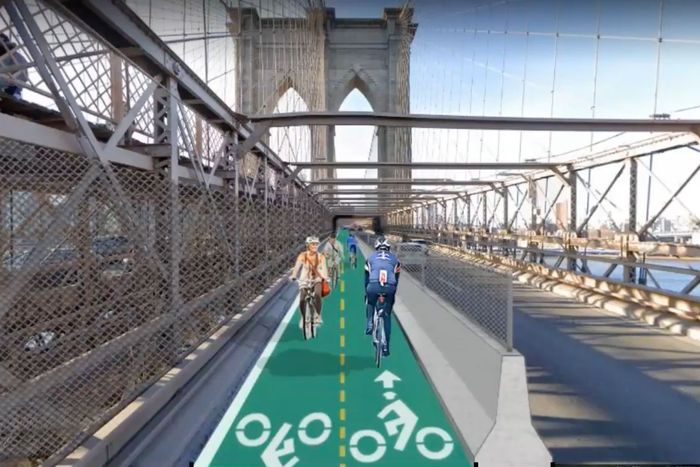
There are plenty of places in New York City where you’re expected to negotiate your bicycle through a space that’s four feet wide. The aisle of the bike-storage room in the basement of your building, if you’re lucky enough to have one of those. Your apartment’s foyer, if not. The little channel between a Citi Bike dock and the curb. The gap between Bill de Blasio’s idling SUV and the entrance to the Park Slope Y. (Kidding; that’s at least 20 feet. He probably likes the walk!) And now, in the renderings unveiled this week, the bike lane across the Brooklyn Bridge. The difference, of course, is that you’re supposed to be riding there, at full speed.
On Tuesday night, DOT engineers presented new drawings and maps of the bike path as part of the mayor’s “Bridges for the People” initiative. It’s the fulfillment of a de Blasio promise from January, and it replaces the innermost lane of the bridge’s Manhattan-bound car traffic. They show a two-way path replacing one lane of cars, set apart with concrete barriers and fencing, that will open this fall. It’s four feet wide in each direction, which is just barely enough for two pairs of handlebars abreast.
Let’s be clear: Any dedicated bike path on the bridge that’s clawed back from traffic is a big improvement. Right now, cyclists and pedestrians share the bumpy boardwalk above the roadway that’s often clogged with gawking tourists. But what DOT is planning is not nearly ambitious enough for a crossing on what’s arguably one of the most famous bridges in the world in a city with the largest bike-share system outside of China that claims it wants to decrease the number of trips taken in cars. According to NACTO’s urban bikeway design guide, the “desirable” width for a two-way cycleway is 12 feet. But it should probably be a little bit wider than that to take the incline in the bridge’s approach into account; people on bikes need more space to adjust speeds as they travel uphill or downhill. This tight two-way setup also begins and ends with a convoluted meander of connecting paths at either side of the bridge, which is a reliable recipe for collisions and crashes.
Following the largest one-year expansion of protected-bike-lane construction in New York City’s history (28 miles were installed citywide) and a biking boom that hasn’t waned, even in cold weather (bike counts over the East River were up 50 percent in November) these types of half measures on one of the city’s busiest commuting corridors don’t add up. The nearby Manhattan Bridge, as reporter Julianne Cuba noted, gets thousands of riders on its dedicated path each day. It’s just shy of ten feet wide.
In an alternate timeline, the city would have widened the promenade so people on bikes got fresh air and skyline views instead of being condemned to the car cage below. But even with an imperfect path, the bridge is certain to get even more riders. So let’s hope this is only a stopgap solution, and once the city sees how crowded this narrow bike path gets at peak hours, cyclists will gain a full Brooklyn-bound lane.




